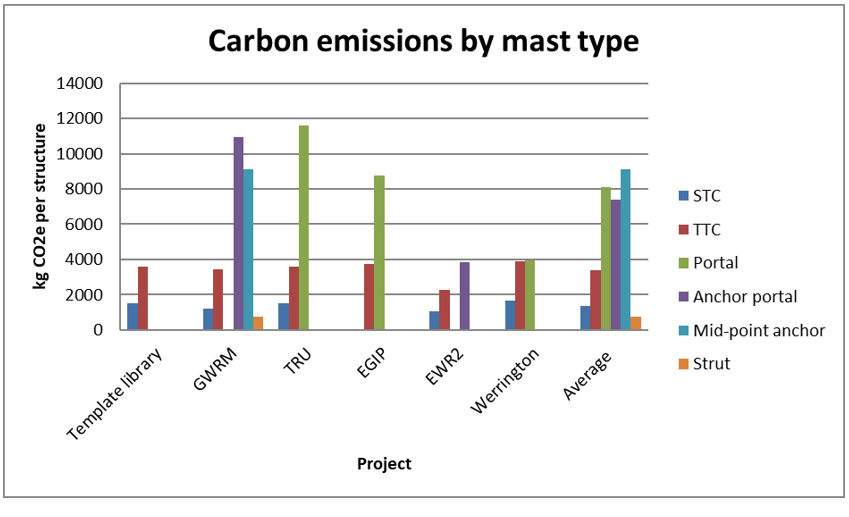Case study: Electrification Embodied Carbon Savings
Company: Network Rail
What’s the issue being addressed?
The railways in Britain are currently undergoing their biggest period of modernisation since they were built. Many of the busiest routes are being electrified to allow for faster, greener, more reliable train journeys. The ultimate goal of electrification is to reduce the carbon impact of the railway and reduced carbon emissions generally lead to reduced costs. With investment in railway electrification to continue in the coming years, understanding and managing the environmental and sustainability impacts of this work is essential.
How was this solved?
Five carbon assessments were conducted and four key electrification infrastructure impact areas identified:
- Overhead Line Electrification (OLE) structures
- Foundations
- Wiring
- Civils interventions
The five projects completed their carbon assessment in different ways, with some using templates from the RSSB Rail Carbon Tool package library and others inputting data manually based on the weights, quantities and types of materials; resulting in a range of results across each of the four impact areas.
The carbon associated with OLE structures was calculated by the five projects using the RSSB Rail Carbon Tool, with the results displayed in figure 1. For the purpose of this assessment the structures are assumed to be standard sizes for a two track railway.

Figure 1: This figure shows the OLE mast embodied carbon values for the Rail Carbon Tool template library, Great Western Route Modernisation (GWRM), Transpennine Rote Upgrade (TRU), Edinburgh Glasgow Improvement Programme (EGIP), East West Rail 2 (EWR2), Werrington and the average values. STC refers to Single Track Cantilever and TTC refers to Two Track Cantilever overhead line structures.
Differences in results, for instance for mid-point anchors on the GWRM and EWR2 projects, can be explained by the different weight and type of steel entered into the tool for each assessment.
Foundations are a key component of the electrification infrastructure but also a big contributor to the overall carbon emissions. The type of foundation used depends on the ground conditions, therefore innovative solutions for each foundation type are required to reduce overall impacts.
While the requirement to install foundations and new OLE structures is standard for railway electrification projects, impacts to surrounding railway infrastructure will be specific to each project. Interventions such as partial and full bridge reconstructions, track lowers and impacts to tunnels, embankments and stations will have additional carbon impacts.
The Transpennine Route Upgrade project modelled the potential impacts to over 70 cross track structures along 45 miles of route, ranging from minor works to culverts and aqueducts to reconstructions of road and rail over and underbridges. Standard overbridges were shown to have the largest carbon impacts on the project civil interventions.
What were the outcomes?
Average carbon emissions of electrifying one mile of railway
Over one mile of railway typically there will be an OLE structure every 50m, resulting in embodied carbon emissions of 107 tonnes CO2e. A total of 70 foundations will be required for these structures, adding carbon emissions of 160 tonnes CO2e. The impact of wires along one mile of railway is 47 tonnes CO2e (for catenary, contact, earth, auto-transformer and return conductor wires), giving a total value of 313 tonnes CO2e for the materials required to electrify one mile of standard railway.
The additional carbon impacts of civils interventions need to be considered on a project by project basis as the amount and type on interventions will differ with the layout of the railway and locations of structures.
Impacts from new permanent way (rails, sleepers and ballast) were not considered as part of the standard emissions of electrifying railways as it was not required by every project. Where new permanent way is required the additional impacts can be significantly higher than that for new overhead electrification infrastructure over 1 mile of railway.
Reducing the carbon impact of electrification
The GWRM project implemented two design changes which reduced the embodied carbon of electrification works per mile by 20 tCO2e on the project:
- Reduction in the thickness of steel used in the OLE masts from 16mm to 12mm,
- Optimisation of foundation depths to reduce the length of piles required by up to 10%.
Two of the major hotspots identified in all of the calculations were emissions from OLE structures and foundations, in particular concrete foundations. There are several potential ways of reducing these hotspots depending on the locations and ground conditions:
- Modifying standard structures and wiring systems to be able to increase distances between structures up to 80m per mile of railway,
- A helical steel reinforcement design could be implemented for concrete auger foundations,
- Pre-augured driven steel piles could be utilised in areas where the bedrock or strata is close to the surface,
- Reducing the size and weight of OLE structures would lead to a corresponding reduction in the required size of foundations. Solutions such as utilising aluminium within the structure could achieve this,
- During design, impacts to over/under bridges, tunnels, embankments, retaining walls and stations should be considered and minimised to reduce the overall impact.
Principles
Reducing our environmental impact, carbon smart, optimising the railway
Asset/ operations
Infrastructure
Organisation type
Network Rail

